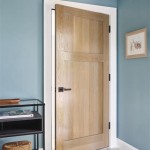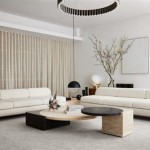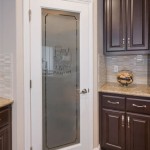Choosing the Right Color for Interior Doors and Trim
The seemingly simple decision of what color to paint interior doors and trim can significantly impact the overall aesthetic of a home. These architectural details, often overlooked, provide opportunities to enhance a room's style, define spaces, and complement existing design elements. A well-considered color palette for doors and trim can create a cohesive and polished look, while a poorly chosen color scheme can detract from the room's intended ambiance. This article explores factors to consider when selecting colors for interior doors and trim, covering popular options and offering guidance for achieving a harmonious and visually appealing result.
Before delving into specific color suggestions, it is crucial to understand the role that doors and trim play in interior design. Trim, encompassing baseboards, crown molding, door casings, and window casings, provides a visual framework for a room. It highlights architectural features, adds depth and dimension, and creates a sense of completion. Doors, on the other hand, serve as both functional elements and design accents. They define entryways, separate spaces, and contribute to the room's overall style. The color of these elements should therefore be chosen with a clear understanding of their intended function and aesthetic impact.
Understanding the Impact of Color Psychology
Color psychology plays a significant role in how individuals perceive and experience a space. Different colors evoke different emotions and associations, influencing mood and creating a specific atmosphere. When selecting colors for interior doors and trim, it is important to consider the psychological impact of each hue. For example, white and off-white shades are often associated with cleanliness, simplicity, and openness, making them popular choices for creating a bright and airy feel. These neutral tones can also make a room appear larger and more spacious.
Conversely, darker colors, such as charcoal gray or navy blue, can evoke feelings of sophistication, drama, and intimacy. These hues are often used in more formal settings or to create a cozy and inviting atmosphere. However, it is important to use darker colors judiciously, as they can also make a room appear smaller and more enclosed. The choice of color should therefore be aligned with the desired mood and the overall design intent for the space. Furthermore, the existing natural light within a room should be considered, as it can significantly alter the perception of color. A color that appears vibrant under bright light may appear dull or muted in a poorly lit space.
Beyond the basic psychological associations, the cultural context of color should also be acknowledged. Different cultures may have varying interpretations and symbolic meanings associated with specific colors. While these nuances may not be a primary concern for most homeowners, they can be a factor to consider when aiming for a particularly authentic or culturally sensitive design.
Exploring Popular Color Options for Doors and Trim
Several color options have consistently proven popular for interior doors and trim, each offering distinct advantages and aesthetic qualities. White remains a classic and versatile choice, providing a clean and timeless look that complements a wide range of interior styles. Off-white shades, such as cream or ivory, are also popular alternatives, offering a softer and warmer feel than stark white. These neutral tones are particularly well-suited for traditional or transitional interiors, creating a sense of understated elegance.
Gray has emerged as a contemporary favorite, offering a sophisticated and versatile alternative to white. Various shades of gray, from light and airy to deep and dramatic, can be used to create a range of different effects. Light grays can create a sense of spaciousness and modernity, while darker grays can add depth and visual interest. Gray also serves as an excellent backdrop for showcasing other colors and textures in the room. Furthermore, gray complements both warm and cool color palettes, making it a highly adaptable choice.
For those seeking a bolder and more expressive look, consider using accent colors for interior doors and trim. This can involve painting doors in a contrasting color to the walls or using a bright and unexpected hue to highlight architectural details. When using accent colors, it is important to maintain a sense of balance and harmony. Choose colors that complement the existing color scheme and avoid overwhelming the space with too many contrasting elements. Accent colors work best when strategically used to draw attention to specific features or to create a focal point within the room.
Wood stains can also be used on doors and trim, offering a natural and warm aesthetic. The choice of wood stain will depend on the type of wood and the desired level of formality. Light stains can create a casual and rustic feel, while darker stains can add a touch of sophistication and elegance. When using wood stains, it is important to ensure that the finish is durable and resistant to wear and tear. A clear topcoat can provide added protection and enhance the natural beauty of the wood.
Matching or Contrasting: Establishing a Cohesive Look
One of the primary decisions when choosing colors for interior doors and trim is whether to match or contrast them with the walls. Matching doors and trim to the walls can create a sense of continuity and spaciousness, making the room appear larger and more cohesive. This approach is particularly effective in smaller rooms or in spaces with low ceilings, as it minimizes visual distractions and creates a more streamlined look. However, matching colors can also result in a somewhat monotonous appearance, lacking visual interest and character.
Contrasting doors and trim with the walls can add depth, dimension, and visual interest to a room. This approach involves using colors that complement or contrast with the wall color, creating a focal point and highlighting architectural details. For example, painting white trim against a colored wall can create a crisp and clean look, while using a darker color for the doors can add a touch of drama and sophistication. When contrasting colors, it is important to consider the overall color palette and ensure that the chosen colors work harmoniously together. Avoid using colors that clash or compete with each other, as this can create a jarring and unpleasant effect.
Another approach is to use different shades of the same color for the doors and trim and the walls. This creates a subtle and sophisticated effect, maintaining a sense of unity while adding depth and dimension. For example, painting the walls a light shade of gray and the doors and trim a slightly darker shade of gray can create a cohesive and visually appealing look. This approach is particularly well-suited for contemporary or minimalist interiors, where understated elegance is desired. The key is to choose shades that are close enough in tone to create a sense of harmony but distinct enough to provide visual separation.
The style of the home can also influence the decision of whether to match or contrast. In traditional homes, matching doors and trim to the walls may be more appropriate, as it reflects the classic and timeless aesthetic. In modern homes, contrasting colors may be preferred, as they add a touch of contemporary flair and visual interest. Ultimately, the choice of whether to match or contrast should be based on personal preference and the overall design intent for the space. Experimentation and visual mockups can be helpful in determining the most effective approach.
Consider the function of the room as well. For example, in a hallway, trim might be used to create a grounding effect, perhaps using a darker color at the baseboards to provide stability and a sense of flow. In contrast, a bedroom might benefit from lighter, more soothing colors on both trim and doors to promote relaxation and a tranquil atmosphere.
When selecting paint finishes, consider the durability and ease of maintenance. Higher-gloss finishes are generally more durable and easier to clean, making them suitable for high-traffic areas like hallways and kitchens. Lower-gloss finishes offer a softer and more muted look, ideal for bedrooms and living rooms. The appropriate finish will depend on the specific needs of each space and the desired aesthetic effect.
In conclusion, the process of selecting the right color for interior doors and trim requires careful consideration of various factors, including color psychology, popular color options, and the decision to match or contrast with the walls. By understanding the role that doors and trim play in interior design and by considering the specific characteristics and needs of each space, homeowners can achieve a cohesive and visually appealing result that enhances the overall aesthetic of their homes.

Pretty Interior Door Paint Colors To Inspire You

Painting Interior Doors A Color Southern Hospitality

Beautiful Interior Door Paint Colors The Turquoise Home

Pretty Interior Door Paint Colors To Inspire You

Beautiful Interior Door Paint Colors The Turquoise Home

A Single Hue Haven Painting Walls Doors Trim The Same Color Tinted

What Colour Do I Paint My Internal Doors Making Your Home Beautiful

New Project Announcement Interior Doors Trim Paint Halfway Wholeistic

How You Can Use Contrasting Paint Trim Colors In Your Renovation Content Co Color Interior Door Painting

Painting Gray Interior Doors How I Did It The Sweetest Digs
Related Posts








